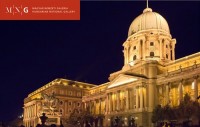Lajos Gulácsy made this fine, artistic drawing of the tragic lovers Paolo and Francesca in Dante’s Divine Comedy in Florence in 1903. Francesca was married to Gianciotto Malatesta, the ruler of Rimini, but she and her husband’s brother, Paolo, fell in love. The jealous husband caught them meeting and in his anger, killed both. On Gulácsy’s drawing, the lovers huddle against one another, casting a melancholic glance into the distance. Paolo lowers his head to his sweetheart’s shoulders while with her hands on her lap, Francesca looks into the distance, perhaps waiting for doom from which there is no escape. Behind the lovers, a characteristic Italian landscape can be seen in the sunset. The pale red sky harmonizes with their clothes, which stand out from the muted green of the landscape. The composition, the elongated lines, Francesca’s long, graceful hands and flowing locks recall the English Pre-Raphaelites. The affectionate, fine lyrical scene is perhaps the most beautiful Hungarian illustration of Dante’s work.
en

